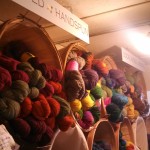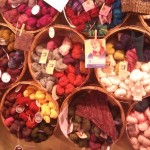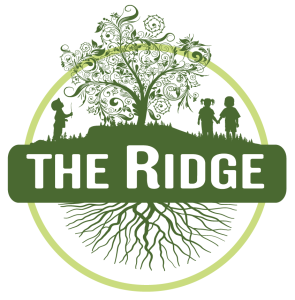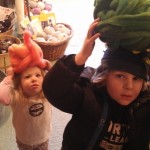-
Natural Materials
Posted on March 20, 2014 by courtneyplatt in Uncategorized.Materials in the classroom (or playroom) have always been something that intrigues me. They have the potential to inspire creativity and wonder or to sit on a shelf unnoticed. In our child-centered environment, the materials are carefully selected for their potential to enhance learning and discovery.
My playroom did not always look like this! When my first child was born, my house was immediately filled with large plastic toys that make loud sounds and had flashing lights. The gifts poured in and I don’t think I actually bought anything for my son until he was about three years old. Now don’t get me wrong, my son seemed to like these toys. He looked at them when he was an infant, engaged with them as he started to crawl and threw them as he got a bit older! Did they ever inspire him? Hold his interest for hours on end? Cause him to wonder about the world?…Probably not.

As I set up my new preschool environment I have been thinking about each material I choose to share with the children. Most of these items will incorporate natural materials and real world objects. Why do we need to buy plastic “kid” versions of a material when they would much rather use the real thing? Would the children in your life prefer a toy cash register or would they rather get their hands on the real deal? Imagine the stories, the hours of dramatic play and the role playing that could ensue from exploring these real materials.
The natural materials we explore in our classroom can be found all around us. I am lucky enough to live in the HudsonValley where beauty literally surrounds me. I can look out one window and see the Shawangunk Ridge and another to see a family of deer passing by our neighbor’s big red barn. Most of these natural materials are open ended, which simply means something that can be transformed based on each child’s imagination and past experiences. For those new to the concept, some ideas include baskets filled with rocks, seashells, pinecones or leaves. Place these items in different areas of your own space and see what the children come up with. Do the rocks become part of the soup in kitchen play or do they end up forming a moat if left in the block area? See what your children are interested in and let this guide you and your decisions for your environment.

Recently I was lucky enough to visit White Barn Farm with my family. For those of you that have never been, you need to plan a visit! They are home to a growing flock of cormo sheep and have an AMAZING fiber shop in Gardiner, NY. In addition they offer a variety of events and classes for all levels of students, even ultra-beginners like me. I wanted to get some local, hand dyed yarn for my children to explore and I was overwhelmed by the choices. Helen helped guide us through the store and was kind enough to explain the dyeing process when my son exclaimed, “I’ve never seen blue and red sheep before!” We also picked up some beautiful green and orange fiber because my children were immediately drawn to it and inspired. My son had created a monkey and a carrot before we even arrived at our home, a mere three miles away. I can’t wait to see what becomes of these materials in our classroom.
My hope for The Ridge is to inspire the children each day. This is not something I can do for them, but what I can do is prepare a thoughtful environment rich in wonder and open ended materials and watch as they learn to inspire themselves 🙂





